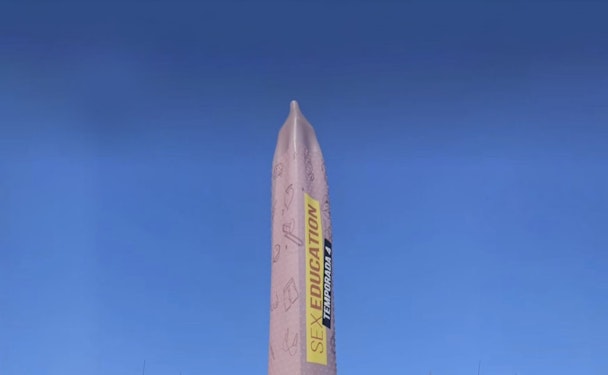Are faux OOHs fake news? What a giant condom tells us about truth on internet
Be afraid, very afraid. There are fake ads everywhere. Ellie Boxall, strategy director at M&C Saatchi, explains why it may not be such a bad thing...

From fake tube stunts for mascara and faux top-of-bus gym ads to a condom big enough to see from space, the advertising industry is currently grappling with the morality of “faking it” to drive conversation and get eyeballs.
For media owners, it erodes their relevance and potentially their bottom lines. Hence, unsurprisingly, they are coming down on the side of transparency and is putting brand reputations at risk. While in the blue corner, creative directors are getting excited about all the creative possibilities this opens up without the constraints of gravity, health, and safety.
However, I feel deja vu - cast your minds back to those shocked few days after the Brexit vote, when we all realized that the echo chamber of our social feeds did not actually reflect the diverse views of the whole of the UK. Is this just another example of us realizing everything is not as it seems online? Or maybe it's a case study for the effectiveness of bus-side advertising, but I digress.
Advertisement
Just like in 2016, we are captivated as an industry, not because it represents a power shift or highlights new creative avenues (augmented and mixed reality has been around for a good few years now - remember this whale?).
It is causing such debate because, just for a second, we all fell for it.
We fell for the giant condom on the obelisk from Netflix or the eyelashes on the tube, which feels unsettling. The uncanny realization that now, with the tech and creative know-how, we can fake whatever we want - it is not just fake news articles; it is imagery, video, voice… anything.
And it is because of this realization and the endless possibilities that CGI, AR and AI technologies unlock, that brands need to continue to lean into and explore what is possible. Back in the late 2010s, brands like Smirnoff reacted to echo chambers and started to help lift a lid on how targeted algorithms work, collaborating with Spotify to diversify listeners’ music tastes by discovering new artists that their unconscious bias might have excluded from their repertoire.
Advertisement
Brands are reasonable, benevolent entities, for the most part, who are held to account online and so can help educate the internet as a whole on just how much you can fake now online.
@jacquemus Giant Bambino bags heading to the Opéra Garnier #Jacquemus ♬ son original - Jacquemus
So, if it is a question about morality, I would rather it was brands who used these technologies than all the other darker uses already causing problems and criminal activity online.
However, it should not be a free-for-all. This is similar to influencer marketing, which also blurs the lines of truth on social media; faux-advertising put out by brands should be labeled as such - something as simple as #CGIad or a disclaimer across all brand-produced faux advertising.
The ASA has commented that as these faux videos sit outside its jurisdiction as they are not paid for. However, as Marcos Angelides recently commented on LinkedIn, this is not always the case, with Adidas recently targeting UK consumers via TikTok with an obviously fake video. And it has a track record with this: remember the Messi billboard after the World Cup win?
Plus, it is not just for the benefit of the public; it is also in the interest of brands and their own reputations, as brand fans and the general internet have long been creating fake adverts, often for their own amusement. I remember a whole afternoon, about ten years ago, spent trying to explain to a global brand based outside the UK (that will remain anonymous) that the OOH they saw shared online was not real, including photographing the real OOH site ourselves. Clarifying whether an ad or piece of content is fake but endorsed by the brand helps create a clear line between brand content and non-brand content.
So, my call to arms for the creative industry is to lean in, go wild, and find out how far we can push what we can “fake” in the digital space - but do not do it duplicitously. Part of the power of these stunts is the fact they could be real - it is more powerful when there is a reveal that they are not, as it continues the conversation and what that means for us all about how much we can “fake” online.

